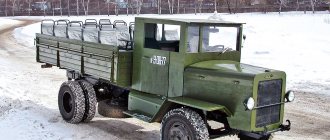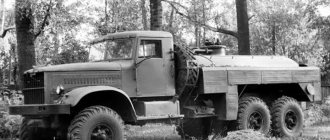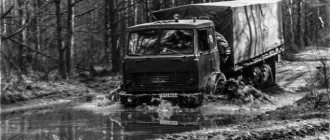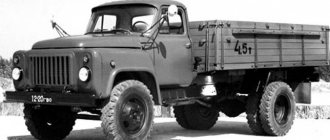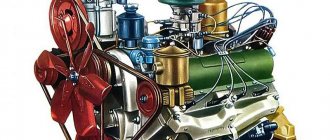Truck versions
Over the years, a large number of modifications have been released. Specifications may vary:
- GAZ 53 f. The manufacturer equipped the truck with a 6-cylinder engine from the previous model. Its power was 82 hp. The vehicle's carrying capacity was 3.5 tons, and the maximum speed was 75 km/h.
- GAZ 53. Eight-cylinder v-shaped engine with a power of 115 hp. Maximum speed 85 km/h.
- GAZ 53a. 8 cylinder v-twin engine. Load capacity 4t, maximum speed 85 km/h.
- GAZ 53b. Dump truck. V-shaped 8-cylinder engine with 120 horsepower. The maximum speed of the car is 90 km h, and the load capacity is 4 tons.
There were specialized versions, such as dump truck chassis, with gas equipment, military, export, truck tractors and chassis for the manufacture of buses.
Characteristics
The model has become widespread due to the following characteristics:
- The length from the front bumper to the rear edge of the body is 6,395 mm.
- The height from the cover to the top edge of the cabin is 2190 mm.
- Width – 2380 mm.
- Base – 3700 mm.
- The distance between the centers of the wheels of the front and rear axles is 1577 and 1650 mm, respectively.
- Load capacity of GAZ 53 is 4500 kg.
- The weight of a fully equipped car is 3250 kg.
- The power unit is an 8-cylinder gasoline engine with a v-shaped arrangement of working cylinders. Power 120 l. With.
- Gearbox: 4-speed manual. 4 gears for forward movement and 1 reverse.
- Travel speed – 90 km/h.
- Fuel tank capacity – 90 liters.
- Wheel formula – 4 x 2.
Vehicle specifications may vary depending on version.
GAZ 53 was used for transporting goods, as well as in the military sphere
Engine
The GAZ 53 internal combustion engine is an eight-cylinder unit. The mixture is prepared by a carburetor. The working cylinders are arranged in a v-shape. Each combustion chamber is equipped with an intake and exhaust valve. The GAZ 53 engine has a lower camshaft. The gas distribution mechanism drive is presented in the form of two gears - metal (located on the crankshaft) and textolite (on the distribution gear). The engine cooling system is liquid. The movement of water in the jacket and radiator is carried out by a pump. It has a timing period from a pulley mounted on the crankshaft.
The car's power unit has a combined lubrication system. Motor oil is used as a lubricant, which is supplied to the parts of the crank mechanism under pressure. The parts of the gas distribution mechanism are lubricated by splashing oil. The pressure in the system is pumped by a gear-type pump. It is driven by a cam-type camshaft. The engine is unpretentious to operating conditions and fuel quality.
Cabin
The model is equipped with an all-metal cabin. It is installed in the front of the car. To reduce the degree of vibration transmitted from the chassis, the cabin is installed on 4 elastic cushions. The following control levers are located inside - steering wheel, gearshift lever, hand brake and PTO (if equipped). On the floor there are three pedals, a switch for high and low beam headlights and a removable hatch for servicing and repairing the gearbox. The turn switch is installed on the steering column. An ammeter, fuel level indicator, oil pressure and coolant temperature are mounted on the instrument panel. Next to the glove box there are dual-mode switches for the windshield wipers and electric interior heater.
Chassis
The frame contains elements of the chassis, transmission, steering, additional equipment and an internal combustion engine. In the front part there is a beam with steering knuckles and a transverse steering rod. It is necessary to change the direction of movement of the car. The truck's drive axle is installed at the rear of the frame. The axles are connected to the frame using semi-elliptical springs. To avoid rocking of the GAZ 53, the front beam is equipped with shock absorbers.
Transmission
The manufacturer installed a 4-speed manual gearbox on the GAZ-53. It has 4 gears for forward movement and one for reverse. Switching is possible after the clutch driven disc has come to a complete stop. The parking brake pads are installed at the rear of the gearbox. When it is turned on, the friction elements are pressed against the inner surface of the drum and block the rotation of the driveshaft. There is a hatch on the right side of the gearbox in the direction of travel of the vehicle. It is necessary to connect the power take-off. The PTO is installed on six bolts with a diameter of 10 mm.
Truck driver's cab
Transmission
The transmission of torque from the gearbox is carried out to the rear axle using a cardan shaft. The bridge is equipped with a hypoid type gearbox with a cross-axle differential. This design allows the wheels of the same axle to rotate at different speeds when turning the vehicle. The transmission of torque from the main pair to the hubs is carried out using axle shafts. They are splined to the differential gears.
Steering
To change the direction of movement, steering knuckles are installed on the front beam. They are connected to each other by a transverse rod. This ensures that both wheels turn at the same angle. The force on the steering bipod is transmitted from a worm-type gearbox. It is installed on the frame on the left side in the direction of travel. To reduce friction between the rotating parts of the gearbox, its housing is filled with lubricant. This reduces the amount of force exerted by the driver when turning the steering wheel.
CAR REPAIR
"An army on wheels." This catchphrase, once again emphasizing the high level of motorization of the Soviet Armed Forces in the late 1960s and early 1970s, has ceased to be just a journalistic cliche, but has acquired the meaning of existing reality. Meanwhile, the large-scale saturation of troops with various types of automotive equipment and numerous types of weapons posed a number of organizational issues to the country's leadership. It was necessary to store this army of thousands of cars somewhere, refuel it, provide it with spare parts, tires, batteries, various types of lubricants, maintenance points and repair shops were needed. But one of the most important; The problem of automotive specialists remained unanswered. In connection with the reform of the Armed Forces of the USSR and the reduction of military service, the Army almost stopped training drivers, leaving only the so-called pre-training, after which young soldiers made a 500-kilometer march in cars and were allowed to independently drive army vehicles. The main burden of training military drivers fell on the shoulders of DOSAAF. Here, in driving schools, thousands of conscripts took training courses and received a driver's license. However, the “army on wheels” required not thousands or even tens of thousands, but a much larger number of drivers. Vocational education institutions and some departmental training centers were involved in solving this problem. In turn, to teach the intricacies of the driver’s business, it was necessary to expand the educational material base. Training organizations were allocated new cars, training manuals, additional limits on fuels and lubricants, etc. After receiving additional orders for new trucks, a group of instructors from one of the educational institutions went to the Gorky Automobile Plant. The city on the banks of the Volga welcomed us with bright spring sunshine, and a few days after paperwork was completed in the sales department, the recipients of the cars found themselves at the finished product storage area. Armored personnel carriers and armored reconnaissance patrol vehicles, wrapped in tarpaulins, stood in even rows; trucks and GAZ-66 chassis gleamed with fresh paint, which somewhat resembled clumsy tadpoles. And here are our brand new GAZ-53A, all so neat, clean and, like all the equipment present on the site, painted in a protective color. Upon closer examination, it turned out that the cars were not quite ordinary, but a special army configuration GAZ-53A-016. They differed from the standard ones by an additional 105 liter fuel tank installed on the left under the platform (the same as the GAZ-66) and an engine pre-heater. In the cockpit, under the instrument panel, there is a fuel indicator switch in the tanks and an instruction plate. The mounting bracket for the machine gun also commanded respect, but what impressed me the most was the spare parts kit. Among the usual tools here were an axe, a saw, a shovel, a tow rope, a canvas bucket, cans for gasoline and oil, snow chains, insulating covers for the hood and radiator trim, a set of spare parts (ventilation belts, light bulbs, gaskets, etc.) and which is quite unusual - an electric vulcanizer and a first aid kit for tire repair. Next, as expected before a long journey, is obtaining transit license plates, a general inspection of the vehicles and checking the condition of the fasteners. True, the local native from the sales department was quite surprised by the latter circumstance: “What are you guys! First time or what? It's not customary for us to run around the car with keys. These are cars manufactured to special order, with acceptance by the customer. You see the red star on the windshield - a sign of military acceptance! Get in boldly and go where you want.” Indeed, there was a small star in the upper right corner. A slight turn of the key and the high-spirited GAZ eight responded with an even, muffled rumble. And really, everything is fine. Soon a column of brand new trucks formed a chain and moved towards the Volga bridge, dousing passers-by with the smell of fresh paint. The Gorky Automobile Plant worked at full capacity, daily delivering hundreds of cars “to the mountain”, which were sent to their consumers on railway platforms, river barges and self-propelled vehicles. The GAZ-53 owes its birth to its younger brother, the GAZ-52 truck. In 1955-1956 KEO GAZ designers have designed a promising model of a truck designed to replace the GAZ-51. Several different versions of the GAZ-52 were considered, including with an in-line prechamber engine and a Y-shaped carburetor “six” with a displacement of 3.75 liters and a power of approx. 110 hp However, the development of the new engine progressed extremely slowly, and the designers turned their attention to a new V-shaped eight-cylinder engine designed for a large-class passenger car. After limiting the power, it could be used on a mass-produced truck. The proposed project also promised considerable economic benefits. It became possible to create a large number of engine modifications for use on Chaika vehicles, buses, tracked transporters, and military vehicles. However, the use of a motor with a power of 110120 hp. for a truck with a carrying capacity of 2.5 tons could hardly be considered appropriate, as a result, it became possible to increase the payload to 3.5-4 tons, which in turn required strengthening the frame and suspension, increasing the cargo platform and wheelbase, new tires, changes braking system and steering. This is how the GAZ-52A car appeared, and soon its index was replaced by GAZ-53, taking into account a large number of innovations. The state of affairs was reported to the leadership of the Ministry of Automotive Industry and the government of the country. Soon, the go-ahead was received for final development and serial production of the new truck, and financing of the project began with the simultaneous reconstruction of GAZ. Of course, from the standpoint of today, the development of mass production of cars with a payload capacity of 4 tons can hardly be considered indisputable, but 50 years ago there was a real need for trucks with an increased payload capacity compared to the GAZ-51. The use of the promising GAZ-53 was intended to increase the efficiency of road transport while simultaneously reducing operating costs per ton of transported cargo. It is no coincidence that the Council of Ministers of the USSR and the Central Committee of the CPSU paid close attention to the issues of organizing the development of production of new automobile equipment. In the process of finishing work, the appearance of the GAZ-53 was finally formed. The creation of the machine under the leadership of chief designer A.D. Leading designers B.I. worked at Prosvirin. Shikhov and V.D. Zapoynov, leading designer of the U-shaped eight-cylinder engine P.E. Syrkin, designer of driving axles I.V. Irkhin, designers N.G. Mozokhin, N.G. Mikhailov, V.V. Gnetov, R.G. Zavorotny, D.A. Malyshev, V.N. Kuzovkin, S.V. Nikonov and many other KEO GAZ employees. The design of the GAZ-53 car was developed under the leadership of L.M. Eremeev, the author of such popular cars as the GAZ-12 ZIM and GAZ-21 Volga. Indeed, if you look closely at the appearance and interior of the GAZ-53 cabin, you will feel a subtle similarity with the stylistic solutions inherent in the Volga, giving the truck a special charm and a memorable “face” that is still recognizable in the flow of vehicles. Among the original technical solutions of the GAZ-53, a new U-shaped eight-cylinder engine with a cylinder block and heads made of aluminum alloy should be highlighted. Relatively light (the weight of the engine with equipment, clutch and gearbox is only 318 kg versus 315 kg of the GAZ-51A engine) engine with a displacement of 4.25 liters and a compression ratio of 6.7 developed a power of 115 hp. at 3200 rpm crankshaft. The maximum torque was 29 kgm at 2000-2500 crankshaft rpm. The design features of the engine include a lubrication system with a centrifugal oil filter (centrifuge), an open crankcase ventilation system with a filter plug, and wet-type cylinder liners. Unlike the GAZ-51A, a reinforced single-disc clutch and a new gearbox with synchronizers in 3rd and 4th gears, as well as a new driveshaft were used to transmit increased torque. A rear axle with a hypoid-type final drive and a one-piece banjo beam, a car suspension with the ends of the springs embedded in rubber cushions, a brake system with a hydraulic-vacuum booster, an all-metal cabin with a semi-panoramic windshield and an efficient heater made it possible to create a modern car with a curb weight of 3250 kg and a carrying capacity of 4000 kg, capable of reaching a maximum speed of 86 km/h with a target fuel consumption of 24 liters per 100 km, possessing high dynamic performance, good cross-country ability and maneuverability, smooth ride, reliability and comfort. The advantages of the GAZ-53 include less labor intensive maintenance and greater durability. It was planned to master serial production of the GAZ-53 by 1962, but its production was hampered by the lack of a finished engine. The new engine, which was technologically quite complex, required the creation of additional production facilities with a large amount of equipment. It should be noted that the first eight-cylinder engines for the GAZ-13 “Chaika” passenger cars were manufactured in MSC-2 - that was the name of GAZ’s special workshop, but such technology was unacceptable for mass production of engines. By the Decree of the Central Committee of the CPSU and the Council of Ministers of the USSR dated April 17, 1958, the bicycle factory under construction in the village of Zavolzhye was repurposed for the production of engines with the subsequent production of spare parts and non-ferrous castings. The plant was given the name “Zavolzhsky Motor”. Already in August 1958, foundry shop No. 1 was founded, where the first experimental smelting was carried out in November. A year later, on November 4, 1959, the first ZMZ-21 engine for the GAZ-21 Volga car was assembled using a bypass technology, and in February 1960 its mass production began. The cylinder block of the ZMZ-53 engine was unusual. Huge casting machines were installed to make it. The metal in the mold was under pressure of more than 700 atmospheres, and one half of the mold was pressed against the other with a force of 2200 tons. Every 6-7 minutes a finished casting was obtained. It was the first time that a part of such a large weight and such a complex shape was made in this way not only in the USSR, but also abroad. Engine assembly was mastered at the end of October 1963 and the first engines were sent to Gorky to the GAZ-66 assembly site. Production of the GAZ-53 began in June 1964. For now, let's go back a few years ago. GAZ was actively involved in preparing the production of the new truck and was often ahead of schedule. The body corps team mastered the production of cabs and tails of the GAZ-53, the frame and gearbox were ready. In an effort to master the new truck model as quickly as possible, the car manufacturers decided to organize the production of a transitional modification of the GAZ-53F, which combined the already mastered chassis units with the old 6-cylinder engine and rear axle from the GAZ-51A. Firstly, this solution made it possible to work out the technological processes for assembling the new machine, and secondly, to identify the weak points of the new components and promptly eliminate the noted deficiencies by the time the new engines arrived. The first production sample of the GAZ-53F was assembled on September 23, 1961, and on October 14, the first pilot batch of 25 cars left the main assembly line. One of the cars had a banner on it: “A labor gift from the car manufacturers to the XXII Congress of the CPSU.” Until March 1962, the GAZ-53F was assembled sporadically, in small batches, and then the cars came off the new assembly line and the assembly became organized with an increase in production volumes. Contrary to popular belief, the letter “F” in the designation of the GAZ-53F model (and, unfortunately, many factory editions are guilty of this) means forced, not prechamber: the transitional modification was equipped with boosted up to 83 hp. at 3200 rpm 6-cylinder engine with an increased compression ratio of 6.7, a two-chamber carburetor and intake pipes of increased cross-section. Torque has also increased - 22 kgm at 1500 rpm. On cars of later releases, a centrifugal oil purification filter appeared. The versatility of the Gorky Automobile Plant made it possible to master the forced modification of the GAZ-51A engine without any problems. Since the rear axle with a hypoid final drive also did not have time for the production of the GAZ-53F, the car was equipped with a rear axle of the GAZ-51A type with the installation of a final drive and differential from a GAZ-63 car with a gear ratio of 7.6. This made it possible to some extent maintain the dynamics of a car with a carrying capacity of 3.5 tons (on dirt roads - 3 tons), but it caused a greater load on the rear axle and reduced its durability. To absorb the increasing load, tires of size 8.25-20 and wheel rims with three holes were used. Thus, the design of the GAZ-53F was a kind of symbiosis of old and new, a logical transition from the 2.5-ton GAZ-51A to the 4-ton GAZ-53A. In general, the GAZ-53F did not have much success with its operators and was produced during the lack of a sufficient number of ZMZ-53 engines. In January 1967, when the production of these engines was mastered in the planned volumes, production of the GAZ-53F was stopped. On April 28, 1964, the basic GAZ-53 was shown to the leaders of the party and government. The new model was approved and received a “start in life.” Initially, the GAZ-53 had a payload limited to 3 tons. To avoid overloading, “3 t” signs were large painted in white paint on its nameplate, as well as on the side sides of the body. These cars were produced in small quantities in 1964 and in the first half of 1965. At the same time, a reinforced front axle, a new cardan transmission and steering mechanism were introduced into production, and the load capacity was increased to 4 tons. The new car was given the index GAZ-53A. Its production began in June 1965. I would like to note the characteristic external differences between the GAZ-53F and GAZ-53, which undoubtedly interests many modellers. The GAZ-53F was equipped with a radiator lining designed for several families of new Gorky trucks - the one and a half ton GAZ-56, the 4-ton GAZ-53 and the 2.5-ton GAZ-52 with headlights located in the upper corners, and sidelights slightly below them. There were no rims on the headlights, and their place was taken by special linings, which also performed a decorative function, visually reducing the actual diameter of the headlights. On the left side of the cab, one round rear-view mirror was installed on a retractable tubular bracket. The rear axle from the GAZ-51A was clearly visible from behind. The muffler and exhaust pipe were located on the right along the frame side member. On the GAZ-53 with a U-shaped figure eight, so-called “pants” appeared in the exhaust system, and the muffler itself and the exhaust pipe were attached to the left side member of the frame. Upon closer examination of the car, this is clearly visible. In 1964, a new radiator trim appeared, on which the headlights moved down, closer to the buffer and the road, and the sidelights, on the contrary, took their place and became more visible to other drivers when the turn indicators were turned on. This type of cladding is still found on surviving GAZ cars. To improve rear visibility, the small round mirror was replaced with two spherical irregular oval mirrors, which were mounted on the left and right on folding three-post brackets. Thus, some of the GAZ-53 cars from the first production batches still had the old lining, and at the same time, the GAZ-53F of the latest releases were equipped with a new lining, so that the main differences remained the shape of the rear axle and the location of the muffler. Initially, on the basis of the GAZ-53, it was planned to create a large number of modifications: GAZ-53-05 for constant work with a 3-ton trailer, the GAZ-53P truck tractor for towing semi-trailers with a carrying capacity of 6 tons. In appearance, the truck tractor was more reminiscent of the GAZ-66 without a front drive axle with GAZ-53 chassis and 8.25-20 tires with dual rear wheels. The cabin was used from a GAZ-66; behind it there was a vertical bracket for a spare wheel and a tool box, between which the battery was placed. A fifth-wheel coupling device was attached to the rear of the frame. Work was also carried out on the three-axle GAZ-33 with a 6x4 wheel arrangement and a payload capacity of 7 tons. A GAZ-41 engine with a power of 140 hp was used for this vehicle. The car was tested in 1963, but work on this topic was soon stopped. The northern modification of the GAZ-53S did not see the light of day either. To operate in harsh climatic conditions, in addition to the pre-heater, the car was equipped with a larger-capacity battery, a more efficient cabin heater, double-glazed windows for all windows (except for lowerable side windows), as well as special thermal insulation for the doors, floor, roof and cabin walls. To maintain the thermal mode of the engine, an electromagnetic coupling was used in the fan drive, and all rubber products and tires were made of frost -resistant rubber. Five prototypes of GAZ-53C successfully passed in the winter of 1965-1966. In Yakutia and the Magadan region, interdepartmental tests in the conditions of light -handed storage and temperatures that reached -60 ° C in a wind of 12 m/s were recommended for serial production, but it was not possible to organize the production of northern modifications. The idea of creating a long-drawn truck on the GAZ-53 chassis did not receive further development, although the plant made such cars for use as technological transport. Serially produced by the GAZ-53A-016 military modification already mentioned at the beginning of the article with additional equipment and two fuel tanks with a total capacity of 195 liters, equipped with 3325 kg, as well as a chassis for the GAZ-53A-02 survey car. This car should be told in more detail. In March 1965, the next Plenum of the Central Committee of the CPSU was held, which determined organizational and technical measures to rise in agriculture. The Gorky Automobile Plant, together with the Saransky Plant of Cars Substitutions, was instructed to design and put a car lifting car for 3.5 tons with a three-way unloading for the transportation of agricultural goods. Using the existing achievements, KEO GAO led by the deputy. The chief designer S. Mikhaylov, the leading designer G. Shiryaev, with the participation of the chief designer of the Saransky factory L. Terentyev, in a short time, created the GAZ-SAZ-53B damel. This was one of the first domestic serial dump trucks with three -way unloading. Its release began in 1966 at the Saransky Plant of Commercials. In the same year, the car was exhibited in Moscow at the international exhibition "Modern Agricultural Machines and Equipment" and was awarded a gold medal. The submissive car was equipped with a 3730x2280x588 mm metal platform and a useful volume of 5 m3, and using the removable supervisory sides, which were included in the standard equipment, the volume of the platform increased to 9 m3. The GAZ-53A-02 chassis was used for a dump truck, which differed from the base truck of a 290 mm short of the back of the frame, the absence of a towing device, instead of which towing hooks were installed on the side regiments of the frame. The fastening of the spare wheel was transferred from the right sidewall to the left, because The hydraulic system was attached on the right side. Due to the use of a dump truck in difficult road conditions of rural areas, the bulk of the machines was equipped with tires of the K-10 model with a pattern of increased cross-country cross-country cross-country pattern. GAZ-SAZ-53b was very popular in the village. Soon, another factory was connected to the production of a dump truck - the Frunze car assembly. The cars of this plant were fully consistent with Saransky. In addition to a three-way unloading at the Saransk factory, a SAZ-3502 model was developed with a preliminary lifting of a platform designed for mechanized loading with seeds of planting drilling machines, fertilizers and other agriculturals with a loading height of 2100 mm. The body of a dump truck with a lifting capacity of 3.2 tons, the size of 2860x2260x715 mm had a rear unloading and could overturn, like a conventional dump truck, or with a preliminary rise to a height of 2250 mm. In the latter case, to increase the stability of the machine, the back was based on two hydraulic supports, and the body itself rose with the help of a hinge quadruple. Unfortunately, the limited production capabilities of the Saransk plant did not allow organizing the production of this complex machine, and the serial production of the SAZ-3502 was transferred to the Frunze Auto Armor plant, which began its production in 1969. Consumers have well accepted the GAZ-53A family cars. These were reliable, soundly worked out trucks with good cross and maneuverability, dynamic and traction characteristics. Of course, there were weaknesses-a driven clutch disc, a small gearbox resource, a frame often broke off the dump trucks, and a self-lifting platform did not always withstand the load, but in general it was a good car, a simple, repairing, without special sophisticates of the structure, For which she enjoyed well -deserved respect and love. The manufacturer also carried out a great work on improving the car. In the third quarter of 1967, the vehicles received an alternating current generator and a contact-transistor relay regulator RR-362, and an ammeter and an oil pressure indicator appeared on the instrument panel (control lamps were used on early issues). In September 1969, all cars, starting with No. 403313, began to equip the contact-transistor ignition system. In 1973, GAZ-53A and its modifications were certified for the assignment of a state quality sign. The plastic emblem of the “quality sign” of light gray color was attached to the radiator lining on the right side between the headlight and the pharmacist. In the same year, the cars began to be equipped with side repeaters of the turning indicators, which were placed on the wings of the cab. The production of the GAZ-53-40-40-40-40-685 buses with softer rear springs, the GAZ-66 fuel and telescopic shock absorbers, a modified brake system and electrical equipment was organized. The chassis was equipped with plumage, and instead of the cab, only a frame of the windshield was installed. A small part of such chassis was supplied by the Semenovsky experimental mechanical mechanical plant for the manufacture of special-purpose buses and auto laboratories. In 1974, the interior of the cabin-the instrument shield, the devices themselves, the devices and the clock (some GAZ-53A cars, the only mass domestic trucks were completed by the hours located on the right part of the instrument panel in a special stamp. When the clock was abolished, they got rid of the opening. However, the stamping itself remained until the end of the production of GAZ-53 cabs) was painted in dark gray. Before they were light yellow. Due to the change in the design of the heater, the cabin reduced the volume of the box for small things. So, the operating manual for the car was placed in a special pocket on the rear wall of the cab. In the gearbox, the gear rates of the first gear and rear transmission were changed, and at the same time they abandoned synchronizers. To a certain extent, it was a step back, but the reliability of the gearbox increased. The engine and systems serving it, transmission, chassis, suspension, electrical equipment were subjected to changes, but they were practically not visible from the outside, and the author does not aim to transfer them, but only draws the attention of readers to the external differences of GAZ-53A for the possible identification of cars by year release. On March 28, 1967, a 5 millionth truck had a truck from the beginning of production, it turned out to be GAZ-53A from the gas conveyor. And the release of a 10 millionth truck on March 24, 1981 again fell on GAZ-53A. To increase the volume of production in the assembly workshop, the new main conveyor No. 2. The first Party of the Fifty-Through, left it on February 23, 1976. In November 1976, the assembly of gas-balloon modifications of the GAZ-53-07 car began to work on liquefied gas. These machines were developed by a team of KB UKER under the leadership of the leading designer Yu.V. Maeva. For high technical and economic indicators, the GAZ-53A car twice (in 1976 and 1979) assigned a state quality mark. By the way, the emblem of the “quality mark” itself disappeared from the radiator cladding in 1982. In 1978, the stiffness of the roof of the cab was increased with stamped ribs of stiffness, and the color scheme in which cars painted was added in blue. Until that time, the GAZ-53A and its modifications were painted in khaki and light yellow sand. Small batches of cars were painted in the color of the "sea wave" and "coffee with milk." At least such a fact as an increase in the mileage to the first major overhaul from 120 thousand km to 200, and by the beginning of the 1980s, speaks of a wide scope of work on the modernization of the car and improving its design and its design. And up to 250 thousand km is a very high indicator for a massive truck. In 1983, the next stage of modernization was carried out, aimed at increasing the carrying capacity from 4000 to 4500 kg and a change in engine design. The new ZMZ-53-11 engine was distinguished by a lubricant system with a single-sectioned oil pump and a full-and-flow oil filter with a change of paper element, new cylinders with an increased compression degree, the K-135 carburetor, and the use of a closed crankcase ventilation system. This made it possible to increase to 120 hp. The maximum engine power, reduce fuel consumption by 5-7% and reduce the content of toxic substances in exhaust gases by 1520%. At the same time, springs, elements of the frame and the beam of the front axis were strengthened. Externally modernized GAZ-53-12 was no different from the GAZ-53A model 1982. Only in 1984. The car received a new radiator cladding. This was due to the prospect of the use of new light -signal equipment with enlarged front lamps. From the front buffer, a trim-outlet disappeared, and instead of it there appeared round holes with sewing out. The new radiator cladding differed in light gray coloring, while the car itself was blue or sand. Haki cars had the same lining. In 1986, new front and rear lights appeared, an emergency alarm and a brake system with a separate drive along the axes, equipped with a new main cylinder and two hydraulic amplifiers. An additional tank was installed on the front wall of the cabin under the hood, and an emergency alarm button appeared on the instrument panel and additional control light bulbs. A year later, cars began to be equipped with new rear -view mirrors with a black plastic case, windlex windshields and a contactless ignition system. The GAZ-53-14 chassis was produced on the basis of GAZ-53-12, designed for supplies to the Saransky and Frunze factories, where GAZ-SAZ-3507 dump trucks were mounted on them, similar to GAZ-SAZ-53B. By the way, the length of the body in the latter in 1980 was reduced to 3516 mm, while increasing the height of the sides and thereby preserving the useful volume of the platform. Due to the increase in carrying capacity, the GAZ-SAZ-3507 self-propelled body was strengthened. The SAZ-3502 dump truck index with a preliminary rise in the platform on the GAZ-53-14 chassis was preserved without changes. Since 1983, the GAZ-53-19 cargo cargo car was produced, working on a liquefied gas with a red gas cylinder with a capacity of 170 liters, located on the left under the platform. Another gas-balloon GAZ-53-27 stood on the conveyor in 1984. It was intended to work on compressed gas and had 7 gas cylinders with a capacity of 50 liters, which were located on the frame under the floor of the platform. Due to the increased own mass of the GAZ-53-27 car, its carrying capacity was limited to 4 tons, and the fastening of the spare wheel was transferred to the rear part under the frame. In addition to trucks with the onboard platform, a significant part of the cars was produced in the form of a chassis. The GAZ-53A car and its modifications were widely exported and popular with foreign consumers. The first parties were sent to the external market in 1965, and soon organized the production of special export modifications: GAZ-53-70 for countries with temperate climate and GAZ-53-50 in tropical performance. Cars were exported to almost 50 countries of the world: Hungary, Vietnam, GDR, Cuba, Mongolia, Angola, Afghanistan, Belgium, Finland, Syria, Ethiopia, Yugoslavia and many other states. Foreign experts noted the high durability and reliability of the truck, large overhaul runs and low labor intensity. So, GAZ-53A was recognized in Poland as the best agricultural machine, and in Bulgaria its production was even established. According to the project of Soviet experts in Shumen, a Madara truck plant was built, which assembled GAZ-53A cars, and subsequently GAZ-53-12 from machine tools coming from the Gorky Automobile Plant. A number of nodes and aggregates GAZ-53A were produced on the spot in Bulgaria. In addition, certain parties of cars were assembled from machine tools in Cuba. The “fifty -third” chassis served as the basis for creating a wide variety of specialized cars on its basis. Already when creating the GAZ-53, it was supposed to place about 40 specialized bodies on its chassis, and when the production reached the planned volumes, the score of special equipment went by hundreds. Many plants built autofurgons, repair shops, tankers, buses, fire engines, auto-scrames and other products using the GAZ-53A chassis. The theme of specialized cars is very extensive and deserves a separate narrative. Buy a diploma with an entry in the register in Irkutsk Buy Irkutsk diploma. The release of trucks of the GAZ-53-12 family was discontinued in January 1993, and GAZ-3307 took its place on the conveyor. In total, 3,336,286 pcs were manufactured. Cars for 32 years of production, the eccentricity of the design of this unique machine, which became the most common truck of the Soviet Union, was confirmed. Of course, from time to time on gas they prepared a replacement for him. In the early 1970s. The version of the new 4-ton GAZ-54 with an altered appearance was worked out, and in 1975-1977. The projects of the modernized GAZ-53-11 were considered with a new cabin interior and plumage. However, for a number of reasons, making global changes to the design of the car and a change in its harmonious appearance was recognized as inappropriate. Such work required additional financial costs, updating production, technology change, expansion of the volume and assortment of components, so GAZ-53 did not change much over the years. Only in the late 1980s, when the gas was in full swing on the re-equipment of production facilities for the release of a new generation of diesel cars, a real replacement appeared for the order of obsolete design of the Fifty-third. However, behind the new cabin, plumage and the GAZ-3307 cargo platform, the GAZ-53 basis is still guessing-in fact, the same power unit, transmission nodes, suspension, and chassis. So the life of the legendary truck continues in the XXI century.
Advantages and disadvantages
The vehicle has both advantages and disadvantages. This should be taken into account when choosing a truck. The truck has the following advantages:
- Unpretentiousness to fuel quality. The engine runs stably regardless of the quality of gasoline.
- Easy to operate and repair. A person who does not have special knowledge and experience can troubleshoot problems. Most problems can be corrected in the field.
The disadvantage of the car is the high noise level in the cabin when driving and the lack of a hydraulic booster . At medium and high speeds the engine produces a high level of noise. This requires the installation of additional sound insulation. Due to the lack of power steering, the driver must make great physical efforts to control the car.
Specifications
Power unit
The Gorky Automobile Plant provided as many as 3 engines. Among them was the presence of an 8-cylinder V-shaped 4-stroke 4.67 liter gasoline engine ZMZ-5231.10.
It can be classified as European standards Euro-3. The engine runs on AI-80 or A-76 gasoline. If you apply additional adjustment, you can use AI-92 gasoline. It was also planned to install a 4-cylinder, four-stroke, 4.75-liter, 125-horsepower diesel engine “MMZ D-245”, which had turbocharging, liquid cooling, direct fuel injection and a charge air cooler.
This engine already complied with the Euro-4 environmental framework. His compression was already equal to 17 units, and he weighed all 430 kilograms. The last representative of this line of engines was YaMZ-5344. It was a four-cylinder, four-stroke diesel power unit with turbocharging, liquid cooling, direct fuel injection and a charge air cooler.
The engine complied with Euro-4 environmental parameters and had a 4.43 liter displacement with a rated power of 134.5 horses. The compression ratio was 17.5. The installation of a pre-heater was provided as a separate option.
Transmission
All diesel powertrains have been synchronized with a 5-speed manual gearbox. The work is carried out using an installed single-plate friction dry clutch, which has a hydraulic control drive.
But for gasoline engines, a 4-speed manual gearbox was provided, which could be easily distinguished by the characteristic howl that it emitted while driving.
Suspension
She is presented here as an addict. At the front there are semi-elliptic springs with shock absorbers. At the rear there are semi-elliptic springs with additional springs. The ends of the main sheets of all springs were installed in the rubber pads of the support brackets.
The drive goes to the rear twin wheels. The suspension was slightly redesigned, after which it was possible to better adapt it for Russian roads.
Steering
It has a worm mechanism, similar to a globoidal worm with a three-ridge roller.
Electrical equipment can support its own operation at 12 volts. The model did not receive a hydraulic power steering wheel.
Brake system
It is considered to be one of the most reliable. It includes brakes and hydraulic drive. In addition, the system has a pair of brake circuits, one of which is responsible for the spare brake. Each circuit has a hydraulic vacuum booster, together with a vacuum cylinder with a shut-off valve.
Thanks to vacuum cylinders, it is possible to achieve independent power supply to the circuits. The vacuum number is monitored using special vacuum measuring instruments, which are equipped with red indicators.
If the vacuum volume reaches the minimum reading, the lamp will begin to glow.
There is also a parking brake, and it is represented by a mechanical method of action, and it is installed on the transmission. Drum mechanisms are used to perform braking. Specifications
| engine's type | ZMZ-511.10 |
| Travel speed (maximum) | 90 km/h |
| Load capacity | 4.5 t |
| Engine power (nominal) | 92 kW |
| Rotation frequency | 3200 rpm |
| Number of engine cylinders | 8 pcs |
| Cylinder diameter | 9.2 cm |
| Piston stroke | 8 cm |
| Working volume | 4.25 l |
| Fuel tank volume | 105 l |
| Fuel consumption per 100 km (speed 60 km/h) | 19.6 l |
| Fuel consumption per 100 km (speed 80 km/h) | 26.4 l |
| Front track size | 1.7 m |
| Rear track size | 1.56 m |
| Wheelbase | 3.77 m |
| Clearance under the rear axle | 0.265 m |
| Clearance under the front beam | 0.347 m |
| Braking distance (speed 60 km/h) | 36.7 m |
| Weight (total) | 7.85 t |
| Weight (curb) | 3.2 t |
| Width | 2.33 m |
| Cabin height | 2.35 m |
| Length | 6.33 m |
| Body type | unloadable on 3 sides |
| Body dimensions inside (length, height, width) | 3.52x0.52x2.28 m |
| Body volume (standard sides) | 5 m³ |
| Body volume (extension sides) | 10 m³ |
| Underbody area | 8 m² |
The legendary GAZ-53. History of the Gas 53 truck and technical characteristics!
GAZ-53 is one of the most famous and popular Soviet trucks. It belongs to the 3rd generation family of medium-duty trucks. It was produced from 1959 (serial production from 1961) until the beginning of 1993 at the Gorky Automobile Plant. With its modifications it was the most popular truck in the USSR. The total number of cars produced is more than 4 million.
Story.
In October 1961, the 3.5-ton GAZ-53F, 82 hp, began production. In July 1964, the GAZ-53 itself began to be produced - a 4-ton truck with a V-shaped 8-cylinder ZMZ-53 engine, 115 hp. In 1965, the name changed to GAZ-53A. This model was produced in various versions for many years until 1983. The GAZ-53-02 chassis was used for dump trucks, the GAZ-53-40 was used for buses, and the GAZ-53-11 chassis was used for specialized vehicles.
Since 1983, the GAZ-53-12 model was released. The radiator has a different lining, a new cylinder head has appeared, and the chassis has also undergone changes. The carrying capacity became 4.5 tons.
In 1990, the GAZ-3307 model appeared. This is where the story of the GAZ-53 ends, but quite a lot of these vehicles are still in use today.
Interior and exterior of GAZ-53.
The GAZ-53 looked very modern for its time. A one-piece radiator trim was made flush with the headlights. The frame was very durable. The gas tank is located under the driver's seat. The filler neck was located at the edge of the driver's door, behind the cab. When switching to gas fuel, this circumstance turned out to be very convenient, since the gas cylinder could be installed under the body, whereas other trucks had a gas tank there.
The starting technology was modern at that time - an electric starter with a retractor relay, there was a good heating system and electric windshield wipers.
The driver and passenger seats were made as one unit. But, nevertheless, it was comfortable to sit in the cabin even in winter in warm clothes. There are places for tools, spare parts and other necessary things.
Engine Gas 53
The engine on the GAZ-53-12 is ZMZ-53, overhead valve, with an aluminum block and cylinder head. The distributor and ignition coil quite often failed due to design flaws. Before major repairs, the car managed to travel 400 thousand kilometers. The engine was not particularly economical. To somehow correct this, instead of a single-chamber carburetor, a two-chamber carburetor was later used.
GAZ-53 is equipped with spring dependent suspension. The front suspension has telescopic shock absorbers. The steering wheel does not have a power steering, which is why only physically strong people could drive such a car. To change gears, you need to double-depress the clutch. The cardan transmission consists of 2 shafts, which are connected to each other using Hooke's joints.
Despite some shortcomings, the GAZ-53 was distinguished by its simplicity of design and repairability, and there were always enough spare parts for this vehicle.
Export
GAZ-53 was exported to the countries of the socialist camp: Poland, East Germany, Romania, Czechoslovakia, Yugoslavia, Hungary, Vietnam, Mongolia, as well as Finland. From 1983 to 1991, the assembly of the GAZ-53-12 was carried out by the Bulgarian enterprise Madara.
Trucks of this assembly had diesel of their own production, which was produced under license from Perkins (England).
Technical characteristics of GAZ-53
| Engine: | 125 hp/3,200 rpm, 8-cylinder, V-twin, 4-stroke, carbureted, 4,254 cc. cm Bore/Stroke: 92/80 mm |
| Transmission | 4 forward + 1 reverse |
| Length | 6 395 mm, |
| Width | 2 280 mm, |
| Height | 2 190 mm |
| Base | 3 700 mm, |
| Ground clearance | 265 mm |
| Curb weight | 3,200 kg |
| Load capacity | 4000 kg |
| Tire size | 8,25-20 |
| Fuel tank capacity | 90 l |
| Maximum speed with full load on the highway | 90 km/h |
| Control fuel consumption at a speed of 40 km/h | 24 l/100 km |
Add a comment
History of creation
The model entered mass production in 1961. The manufacturer completed production of trucks in 1993. Over the years, several modifications have been released. They differed in the characteristics of the unit and the type of chassis. The first cars were produced with a 6-cylinder power unit. It had an in-line arrangement of working cylinders and a liquid cooling system. Afterwards, a gasoline unit with 8 working chambers, the maximum power of which was 120 horsepower, began to be installed on the GAZ-53.
Description and device
The car is made on the basis of a frame consisting of two channels connected by cross members. The engine compartment is located at the front of the truck. Gas-53 has a 4 x 2 wheel arrangement. The drive from the gearbox is to the rear axle. The chassis type differs depending on the version. The manufacturer equipped the truck with a mechanical steering column. Its gearbox includes a worm gear. No hydraulic booster is provided. This requires the driver to exert great physical effort when turning the steering wheel.
The GAZ 53 truck was produced in several modifications
The electrical circuit of the GAZ 53 car is built on a single-wire principle. The negative contact is the car body, it is connected to the battery. Power sources are a 12-volt battery and a belt-driven generator. While the engine is running, the battery is charged. The body of the Gorky Automobile Plant model was manufactured in several versions:
- Wood. The front board is rigidly fixed to the base. The side and rear panels are mounted on metal hinges. Loading and unloading is carried out from any of the three sides.
- Metal. Installed on a dump truck. The back and side sides are movable. Unloading is carried out on the side or backwards. In the center of the bottom of the metal body there is a bracket designed for mounting a hydraulic cylinder.
- Metal closed type. The body is equipped with side or rear doors. This model is widely used for transporting food products.
On the basis of the GAZ 53, aerial platforms, fuel tankers, fire trucks, etc. were manufactured. The manufacturer also produced vehicles intended for the needs of the army.


